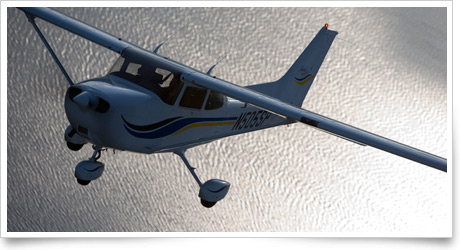| The following stories from the April 6, 2012, edition of AOPA ePilot were provided to AOPA members who expressed an interest in the particular subject areas. Any AOPA member can receive information tailored to their areas of interest by updating their preferences online. |
‘Beyond gliding distance’ As you prepare to take your private, recreational, or sport pilot checkride, your flight instructor asks you increasingly detailed questions about flight planning’s risk management to ready you for queries from your designated pilot examiner.
Today she hands you a sectional chart and asks how you would respond to an invitation to fly your single-engine airplane from your base at Long Island MacArthur Airport in Islip, N.Y., on a direct route of 30 nautical miles to Connecticut’s Tweed-New Haven Airport.
Thirty miles isn’t much—but you quickly observe that about two-thirds of the route is over a wide expanse of Long Island Sound.
Is that a problem?
Not from a regulatory point of view (although you would probably not be permitted to do this while still a student pilot). But it raises some interesting questions.
The prospect of the direct flight causes you to ponder the approximate power-off glide range of your aircraft from a variety of cruise altitudes, at your aircraft’s best glide speed, considering given winds aloft. How long would you find yourself beyond gliding distance at various points along the route?
You could choose a less direct route. Or you could elect to “spiral up” to cruise altitude over land before starting out over Long Island Sound, she suggests.
There’s much to consider—and pilots have diverse opinions about how to proceed, making for spirited debates.
Read AOPA Editor in Chief Thomas B. Haines’s discussion of the risk-assessment question in his March 2011 AOPA Pilot Waypoints column. Flight Training Editor Ian Twombly blogged in November 2008 about the considerations for an 86-nm crossing of Lake Michigan—a route well known to many pilots.
Next your CFI poses a sample aviation knowledge test question: “When an aircraft is being flown over water, under what circumstance must approved flotation gear be readily available to each occupant?”
Here are possible answers: A) At night and beyond gliding distance from shore. B) Anytime the aircraft is beyond power-off gliding distance from shore. C) When operating for hire beyond power-off gliding distance from shore.
You check the regulation and reply, “C.” Flotation devices are required when the aircraft is operated for hire over water and beyond power-off gliding distance from shore.
Correct. For large aircraft, she adds, separate rules apply.
Want to test your risk-management skills from your computer? Create a hypothetical flight and plug the parameters into the Air Safety Institute Flight Risk Evaluator . training productsNoral three-inch seat cushion with backA good sight picture can make all the difference with achieving a good landing. For pilots who need a little boost in the cockpit, Noral’s three-inch seat cushion with back provides height and back support. The cushion is foldable and has a strap to secure it to an aircraft seat, or to be used as a carry handle. It sells for $80 from PilotMall.com. Order online or call 800/249-5730.
Note: Products listed have not been evaluated by ePilot editors unless otherwise noted. AOPA assumes no responsibility for products or services listed or for claims or actions by manufacturers or vendors. final examQuestion: What is the difference between an annual inspection and a 100-hour inspection?
Answer: In terms of what is actually inspected, the annual and 100-hour inspections are identical in scope and detail as noted in appendix D to Part 43 of the federal aviation regulations (FARs). The difference is in who is allowed to perform the inspection. According to FAR 65.85 and FAR 65.87, an airframe and powerplant (A&P) mechanic may perform a 100-hour inspection required by Part 91, while FAR 65.95 allows only an A&P mechanic with inspection authorization (IA) to perform the annual inspection.
Got a question for our technical services staff? Email [email protected] or call the Pilot Information Center, 800/872-2672. Don’t forget the online archive of “Final Exam” questions and answers, searchable by keyword or topic. |



